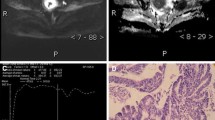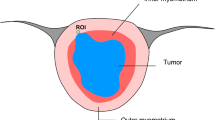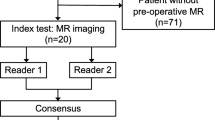Abstract
Objective
To compare the diagnostic accuracy of diffusion-weighted magnetic resonance imaging (DWI) and frozen-section analysis in assessing myometrial invasion in endometrial cancer to guide surgery.
Methods
In this prospective study, 51 women with diagnosed endometrial cancer were examined using magnetic resonance imaging (MRI) and subsequently underwent hysterectomy with intraoperative frozen-section assessment. The MRI protocol included T2-weighted images (T2WI), a dynamic T1-weighted post-gadolinium series, and DWI sequences acquired with b values of 0, 150, and 800 s/mm2. Apparent diffusion coefficient (ADC) maps were obtained in all the studies. Deep myometrial invasion was defined as involvement of ≥50% of the thickness of the myometrium. The final postoperative pathological evaluation was considered as the reference standard.
Results
The accuracy, sensitivity, specificity, positive predictive value, and negative predictive value of DWI for detecting deep invasion of the myometrium were 90.2%, 77.8%, 97%, 93.3%, and 88.9%, respectively. For the intraoperative frozen section, these figures were 90.2%, 73.7%, 100%, 100%, and 86.5%. The precision for both tests was the same using McNemar’s test (p = 1).
Conclusion
In assessing the depth of myometrial invasion, ADC maps show the same accuracy as intraoperative histological studies in endometrial cancers. They also allow for a more precise assessment than conventional MRI sequences. Frozen-section analysis can be avoided if the preoperative MRI study includes DWI sequences and ADC maps.





Similar content being viewed by others
References
Mariani A, Dowdy SC, Cliby WA, et al. (2008) Prospective assessment of lymphatic dissemination in endometrial cancer: a paradigm shift in surgical staging. Gynecol Oncol 109:11–18
ASTEC Study Group, Kitchener H, Swart AM, Qian Q, Amos C, Parmer MK (2009) Efficacy of systematic pelvic lymphadenectomy in endometrial cancer (MRC ASTEC trial): a randomised study. Lancet 373:125–136
American College of Obstetricians and Gynecologists (2005) ACOG practice bulletin, clinical management guidelines for obstetrician-gynecologists, number 65, August 2005: management of endometrial cancer. Obstet Gynecol 106:413–425
Lin G, Ng KK, Chang CJ, et al. (2009) Myometrial invasion in endometrial cancer: diagnostic accuracy of diffusion-weighted 3.0-T MR imaging—initial experience. Radiology 250:784–792
Rechichi G, Galimberti S, Signorelli M, Perego P, Valsecchi MG, Sironi S (2010) Myometrial invasion in endometrial cancer: diagnostic performance of diffusion-weighted MR imaging at 1.5-T. Eur Radiol 20:754–762
Beddy P, Moyle P, Kataoka M, et al. (2012) Evaluation of depth of myometrial invasion and overall staging in endometrial cancer: comparison of diffusion-weighted and dynamic contrast-enhanced MR imaging. Radiology 262:530–537
Seo JM, Kim CK, Choi D, Kwan Park B (2013) Endometrial cancer: utility of diffusion-weighted magnetic resonance imaging with background body signal suppression at 3T. J Magn Reson Imaging 37:1151–1159
Pecorelli S (2009) Revised FIGO staging for carcinoma of the vulva, cervix, and endometrium. Int J Gynaecol Obstet 105:103–104
Larson DM, Connor P, Broste SK, Krawisz BR, Johnson KK (1996) Prognostic significance of gross myometrial invasion with endometrial cancer. Obstet Gynecol 88:394–398
Ozturk E, Dikensoy E, Balat O, Ugur MG, Aydin A (2012) Intraoperative frozen section is essential for assessment of myometrial invasion but not for hystologic grade confirmation in endometrial cancer: a ten-year experience. Arch Gynecol Obstet 285:1415–1419
Savelli L, Testa AC, Mabrouk M, et al. (2012) A prospective blinded comparison of the accuracy of transvaginal sonography and frozen sections in the assessment of myometrial invasion in endometrial cancer. Gynecol Oncol 124:549–552
Kisu I, Banno K, Lin L-Y, et al. (2013) Preoperative and intraoperative assessment of myometrial invasion in endometrial cancer: comparison of magnetic resonance imaging and frozen sections. Acta Obstet Gynecol Scand 92:525–535
Sanjuan A, Cobo T, Pahisa J, et al. (2006) Preoperative and intraoperative assessment of myometrial invasion and histologic grade in endometrial cancer: role of magnetic resonance imaging and frozen sections. Int J Gynecol Cancer 16:385–390
Sorosky JI (2012) Endometrial cancer. Obstet Gynecol 111:436–447
Wu L-M, Xu J-R, Gu H-Y, et al. (2013) Predictive value of T2-weighted imaging and contrast-enhanced MR imaging in assessing myometrial invasion in endometrial cancer: a pooled analysis of prospective studies. Eur Radiol 23:435–449
Hori M, Kim T, Onishi H, et al. (2013) Endometrial cancer: preoperative staging using three-dimensional T2-weighted turbo spin-echo and diffusion-weighted MR imaging at 3.0 T: a prospective comparative study. Eur Radiol 23:2296–2305
Fujii S, Matsusue E, Kigawa J, et al. (2008) Diagnostic accuracy of the apparent diffusion coefficient in differentiating benign from malignant uterine endometrial cavity lesions: initial results. Eur Radiol 18:384–389
Takeuchi M, Matsuzaki K, Nishitani H (2009) Diffusion-weighted magnetic resonance imaging of endometrial cancer: differentiation from benign endometrial lesions and preoperative assessment of myometrial invasion. Acta Radiol 50:947–953
Author information
Authors and Affiliations
Corresponding author
Rights and permissions
About this article
Cite this article
Gallego, J.C., Porta, A., Pardo, M.C. et al. Evaluation of myometrial invasion in endometrial cancer: comparison of diffusion-weighted magnetic resonance and intraoperative frozen sections. Abdom Imaging 39, 1021–1026 (2014). https://doi.org/10.1007/s00261-014-0134-9
Published:
Issue Date:
DOI: https://doi.org/10.1007/s00261-014-0134-9




